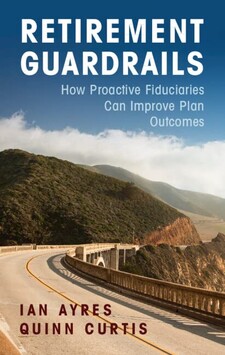How Retirement Plan Guardrails Can Protect Employees

In their new book Retirement Guardrails: How Proactive Fiduciaries Can Improve Plan Outcomes (Cambridge University Press, 2023), Yale Law School’s Ian Ayres ’86 and the University of Virginia’s Quinn Curtis ’09 argue that employers have the fiduciary duty to structure their retirement plans so that employees invest wisely. Though the law has long required that employers include only prudent options in plan menus, Ayres and Curtis make the legal case for proactively helping investors choose among them.

Retirement Guardrails seeks to fill a gap in the academic literature, given that legal scholars have rarely considered whether employers’ fiduciary duty encompasses menu construction, the way investment options are presented within a retirement plan. A bevy of recent lawsuits have accused employers of listing options that carry “imprudently high” fees, therefore breaching their fiduciary duty. As plan menus increasingly draw scrutiny, the co-authors contend that employers should learn whether employees are making substantial menu mistakes, and if so, adopt concrete measures to safeguard investors.
To prove their point, Ayres and Curtis turn to an extensive case study that they know well: how more than 11,000 former and current University of Virginia employees, including both of them, allocate their savings in the university’s retirement plan. “We do not use this plan because it is an egregious example of subpar fiduciary behavior,” they write. Rather, the well-managed plan reveals “how even well-educated employees in a university setting may still fall prey to substantial allocation errors.”
Ayres and Curtis describe three types of allocation errors frequently made by investors: paying excessive fund-level or plan expenses, failing to diversify holdings across asset classes, and exposing portfolios to too much or too little market risk. They find that about 10% of employees make substantial allocation errors. For example, more than one-third of the participants who invested in the University of Virginia’s gold fund had more than half of their plan savings in this one fund.
Most employers have no idea whether plan participants are making such poor choices. That’s because the advisers who administer the plan usually don’t give the employer any information on how individual employees allocate their savings. Employers have fiduciary committees that are given reams of information about the returns of each investment option at quarterly meetings with the advisers, as well as comparisons to the returns of similar funds. But they aren’t told whether individual participants are misusing the menu by creating unbalanced or expensive investment portfolios.
“When reviewing their menu design,” they write, “fiduciaries should learn more and do more.” They argue that fiduciaries should learn whether employees are making menu mistakes. And fiduciaries should correct those mistakes by dropping (a.k.a “streamlining”) funds where misuse is particularly prevalent or “guardrailing” those funds with soft or hard caps on how much can be invested. Guardrail caps are already prevalent with regard to company stock. Roughly two-thirds of plans that offer company stock limit participants’ stake in these shares to 20% of their portfolio.
Guardrails are a way fiduciaries can “constrain but maintain choice,” thereby encouraging participants to invest prudently. They argue there is nothing wrong in offering participants the option to invest in gold (or company stock or even cryptocurrency) as long as the retirement plan doesn’t allow unreasonably large allocations to these esoteric options.
In the closing chapters, the co-authors examine a broader range of systemic problems that affect retirement savings. They sketch constructive possibilities, including “the public option of purchasing supplemental Social Security benefits.” Ayres and Curtis stress that menu construction is only a single, though crucial, means of reforming how people save for retirement. “[T]he struggle to improve retirement protections for Americans is far from over,” they write, “and this book is not the final word on policies that might aid in this struggle.”
Ayres is the Oscar M. Ruebhausen Professor at Yale Law School and a Professor at the Yale School of Management. Curtis serves as Associate Dean for Curricular Programs and The Honorable Albert V. Bryan Jr. ’50 Research Professor of Law at the University of Virginia School of Law. They have previously collaborated on scholarship that addresses retirement savings problems.


